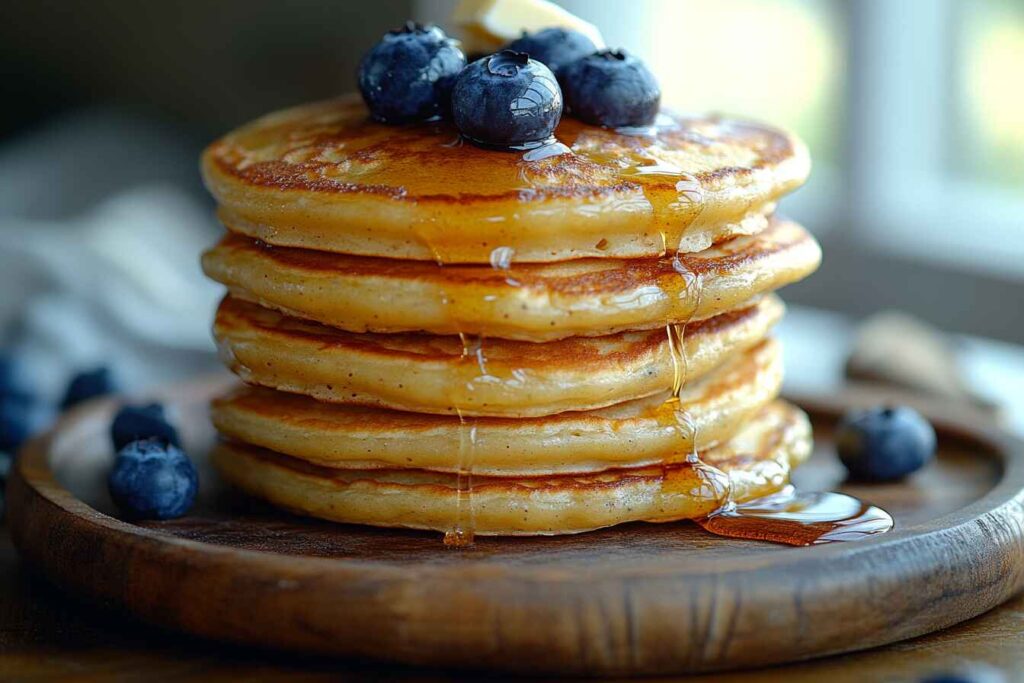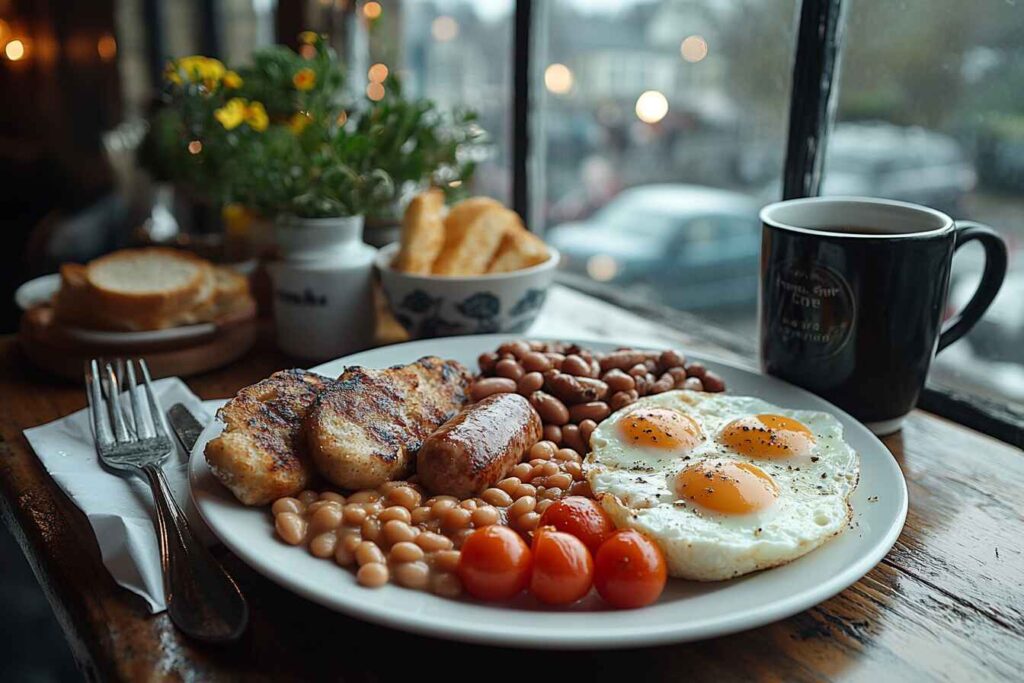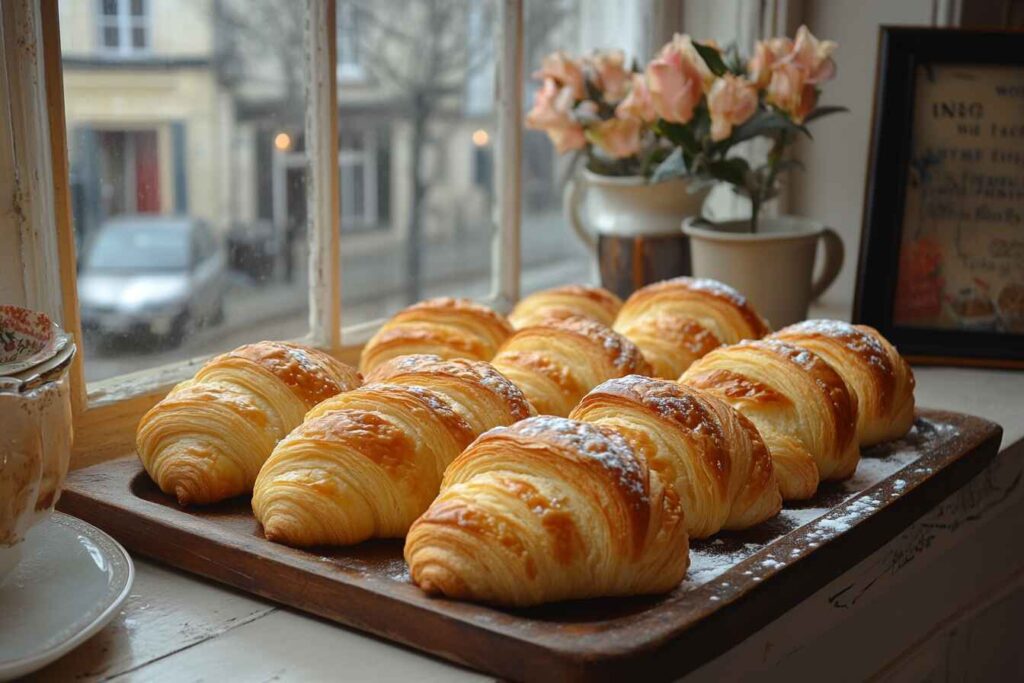What are 3 traditional breakfast dishes? Around the world, breakfast varies widely, reflecting different cultures and histories. Some meals are light and simple, while others are hearty and filling. In this article, we’ll explore three iconic breakfast dishes—American pancakes, the English full breakfast, and the classic French croissant with coffee. These meals aren’t just delicious; they carry centuries of tradition and are loved by millions.
Whether you’re looking for new breakfast ideas or just curious about international morning meals, this guide will take you on a delicious journey. Let’s start with the first dish: the fluffy, golden American pancakes!
1. American Pancakes: A Fluffy Start to the Day
History and Origin of Pancakes
What are 3 traditional breakfast dishes? If you’re thinking of pancakes, you’re on the right track! Pancakes have been around for centuries—ancient civilizations made them using flour and water, cooking them on hot stones. But the classic American pancake, the thick and fluffy version we know today, became popular in the 19th century. Thanks to the introduction of baking powder, pancakes could rise beautifully, making them a staple in American breakfasts.
Among the 3 traditional breakfast dishes we’re exploring, American pancakes stand out for their versatility and comforting taste. In the U.S., pancakes are often served with butter and maple syrup, but there are endless variations. Some people add blueberries, chocolate chips, or even bacon for a sweet-and-savory twist!
When discussing what are 3 traditional breakfast dishes, pancakes deserve a spot because they are enjoyed in many forms worldwide. Whether they are fluffy American pancakes, thin French crêpes, or hearty German Pfannkuchen, these delicious morning treats continue to be a breakfast favorite across cultures.
So, if you’ve ever wondered what are 3 traditional breakfast dishes that have stood the test of time, American pancakes are a perfect example. Next, let’s explore another beloved classic: the famous English full breakfast.

Ingredients Needed for Classic Pancakes
Basic Ingredients for American Pancakes:
- 2 cups (250g) all-purpose flour
- 2 tablespoons sugar
- 1 tablespoon baking powder
- ½ teaspoon salt
- 2 large eggs
- 1¾ cups (430ml) milk
- ¼ cup (60g) unsalted butter, melted
- 1 teaspoon vanilla extract
- Butter or oil for cooking
Step-by-Step Recipe for Homemade Pancakes
Making pancakes at home is easy, but getting them just right requires a little technique. Follow these steps to make the fluffiest pancakes ever!
- Mix the dry ingredients: In a large bowl, whisk together the flour, sugar, baking powder, and salt.
- Prepare the wet ingredients: In another bowl, whisk the eggs, then add milk, melted butter, and vanilla extract.
- Combine the mixtures: Slowly pour the wet ingredients into the dry ingredients, stirring gently. Don’t overmix—some lumps are okay!
- Preheat your pan: Heat a non-stick pan or griddle over medium heat and lightly grease it with butter or oil.
- Cook the pancakes: Pour ¼ cup of batter onto the pan for each pancake. Cook until bubbles form on the surface, then flip and cook for another minute.
- Serve immediately: Stack the pancakes high, drizzle with maple syrup, and add toppings like fresh fruit or whipped cream.
Common Problems and Solutions When Making Pancakes
Even the simplest pancake recipe can go wrong if you’re not careful. Here are some common problems and how to fix them:
Pancakes Are Too Flat: Check your baking powder—it might be expired. Fresh baking powder helps pancakes rise!
Pancakes Are Too Dense: Overmixing the batter develops gluten, making pancakes tough. Mix just until combined.
Pancakes Are Burning Before Cooking Through: Your pan is too hot. Lower the heat to medium-low for even cooking.
Tips for Fluffier and More Delicious Pancakes
- Let the batter rest for 5–10 minutes before cooking. This allows the flour to absorb the liquid, making pancakes softer.
- Use room temperature ingredients. Cold eggs and milk can prevent proper mixing.
- Flip only once. Flipping multiple times deflates the pancakes, making them dense.
- Don’t press down with the spatula. It may seem tempting, but pressing pancakes removes the air pockets that make them fluffy.
Nutrition Facts of American Pancakes
Nutrition Facts (per serving, 2 pancakes):
- Calories: 350
- Carbohydrates: 50g
- Protein: 8g
- Fat: 12g
- Sugar: 10g
- Fiber: 2g
2. English Full Breakfast: A Hearty Morning Feast
What Is an English Breakfast?
The English full breakfast, also known as a “fry-up,” is one of the most iconic morning meals in the UK. It’s not just a plate of food—it’s a tradition, a hearty start to the day, and a meal designed to keep you full for hours.
A typical full English breakfast includes eggs, bacon, sausages, baked beans, toast, mushrooms, tomatoes, and black pudding. It’s often served with tea or coffee and sometimes accompanied by hash browns or fried bread. This meal became popular in the early 19th century when the British working class needed a filling meal before long days of labor.
The Essential Components of a Full English Breakfast
Every full English breakfast includes a mix of proteins, carbs, and vegetables. Let’s break it down:
Key Ingredients for a Traditional English Breakfast:
- 2 eggs (fried, scrambled, or poached)
- 2 slices of bacon
- 2 pork sausages
- ½ cup (120g) baked beans
- 2 slices of toast or fried bread
- 1 grilled tomato, halved
- ½ cup (50g) mushrooms, sautéed
- 1 slice of black pudding (optional)
- 1 hash brown (optional)
- Butter and oil for frying

How to Make a Perfect English Breakfast at Home
Cooking a full English breakfast might seem overwhelming, but with the right technique, you can prepare everything perfectly. Follow these steps:
- Start with the sausages: Heat a pan over medium heat, add a bit of oil, and cook the sausages for about 10–15 minutes, turning occasionally until browned and cooked through.
- Fry the bacon: In the same pan, cook the bacon until crispy or to your preferred doneness.
- Prepare the tomatoes and mushrooms: Cut the tomato in half, season with salt and pepper, and grill or pan-fry it for 2–3 minutes per side. Sauté the mushrooms in butter until golden brown.
- Cook the eggs: You can fry, scramble, or poach the eggs, depending on your preference.
- Heat the baked beans: Pour the baked beans into a small saucepan and gently heat them until warm.
- Toast the bread: Lightly toast the bread or fry it in butter for extra crunch.
- Assemble everything on a plate: Serve with a cup of tea or coffee and enjoy!
Common Cooking Mistakes and How to Avoid Them
Sausages Are Burnt but Undercooked Inside: Cook them over medium heat and turn frequently for even cooking.
Bacon Is Too Greasy: Drain it on a paper towel after cooking to remove excess grease.
Eggs Stick to the Pan: Use a non-stick pan with butter or oil, and cook over low heat.
Variations of the English Breakfast Around the World
While the full English breakfast is famous, other countries have their own versions:
- Irish Breakfast: Includes white pudding, soda bread, and sometimes boxty (potato pancakes).
- Scottish Breakfast: Features haggis, tattie scones (potato scones), and Lorne sausage.
- Welsh Breakfast: Sometimes includes laverbread (seaweed puree) and cockles.
Nutrition Facts of a Full English Breakfast
Nutrition Facts (per serving):
- Calories: 700–900
- Carbohydrates: 50g
- Protein: 40g
- Fat: 50g
- Sodium: 1200mg
3. French Croissant and Coffee: A Classic Parisian Breakfast
The Origin and Cultural Significance of Croissants
When you think of a French breakfast, the first thing that likely comes to mind is a golden, flaky croissant paired with a steaming cup of coffee. But did you know that the croissant didn’t actually originate in France?
The origins of the croissant trace back to Austria in the 17th century. The Kipferl, a crescent-shaped pastry, was popular in Vienna before being introduced to France. In the late 19th century, French bakers refined the recipe, adding layers of butter to create the delicate, flaky pastry we know today.
Today, croissants are a staple in French breakfasts, typically enjoyed with coffee or hot chocolate. Unlike American breakfasts, which tend to be heavy and protein-packed, French breakfasts are simple, light, and focused on quality ingredients.

How Croissants Are Made: Traditional Baking Techniques
Making croissants from scratch requires time and patience, but the results are worth it! The secret to their flakiness is the lamination process—layering butter between sheets of dough and folding it multiple times to create hundreds of thin layers.
Ingredients for Homemade Croissants:
- 4 cups (500g) all-purpose flour
- ¼ cup (50g) sugar
- 1 tablespoon salt
- 1 tablespoon instant yeast
- 1¼ cups (300ml) warm milk
- 1¼ cups (280g) unsalted butter (for laminating)
- 1 egg (for egg wash)
Step-by-Step Guide to Making Croissants
Follow these steps to create perfect homemade croissants:
- Prepare the dough: In a bowl, mix flour, sugar, salt, and yeast. Slowly add warm milk and knead until smooth. Let it rest in the fridge for 2 hours.
- Prepare the butter layer: Roll the butter between parchment paper into a rectangle, then chill.
- Laminate the dough: Roll out the dough, place the butter in the center, and fold it like a letter. Roll and fold three times, chilling between each fold.
- Shape the croissants: Roll out the dough, cut it into triangles, and roll each one into a crescent shape.
- Proof and bake: Let the croissants rise for 2 hours, brush with egg wash, and bake at 375°F (190°C) for 20 minutes.
Common Baking Challenges and Fixes for Homemade Croissants
Butter Leaks Out: Keep the dough cold at all times! Warm butter melts and ruins the layers.
Croissants Are Dense Instead of Flaky: Make sure to proof the dough properly before baking.
Croissants Are Too Hard: Avoid overbaking. A golden color is enough—don’t let them get too dark.
Best Ways to Enjoy Croissants for Breakfast
There are many ways to enjoy croissants beyond the classic buttered version:
- Pain au Chocolat: Croissants filled with chocolate for a sweeter treat.
- Ham and Cheese Croissant: A delicious savory twist.
- Almond Croissant: Filled with almond paste and topped with sliced almonds.
- With Coffee: A must! A strong espresso or café au lait pairs perfectly with the buttery croissant.
Nutrition Facts of a Croissant
Nutrition Facts (per croissant):
- Calories: 280
- Carbohydrates: 30g
- Protein: 5g
- Fat: 16g
- Sugar: 5g
Comparison: How These Breakfasts Reflect Their Cultures
Each of these breakfasts tells a story about its country’s culture:
- American Pancakes: Sweet, comforting, and perfect for a weekend brunch.
- English Breakfast: Hearty, filling, and designed to provide energy for a busy day.
- French Croissant: Light, elegant, and focused on high-quality ingredients.
Common Mistakes When Making Traditional Breakfasts
Here are a few mistakes people make when preparing these breakfasts and how to fix them:
Overmixing Pancake Batter: This makes pancakes dense instead of fluffy.
Burning the English Breakfast Sausages: Cook on medium heat to prevent charring.
Handling Croissant Dough Too Much: Keep it cold and work quickly to maintain the layers.
How to Adapt These Traditional Dishes to a Modern Diet
If you’re looking for healthier or plant-based versions of these breakfasts, here are some ideas:
- Healthier Pancakes: Use whole wheat flour and replace sugar with honey.
- Vegetarian English Breakfast: Swap sausages and bacon for plant-based alternatives.
- Vegan Croissants: Use dairy-free butter and almond milk.
Final Thoughts: Why Traditional Breakfasts Are Still Popular
Despite modern trends, these three traditional breakfasts remain favorites worldwide. Whether you prefer sweet, savory, or buttery breakfasts, there’s something for everyone.
Which of these breakfasts will you try first? Let us know in the comments!

